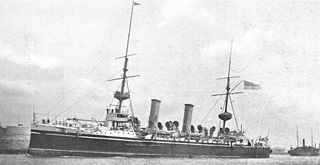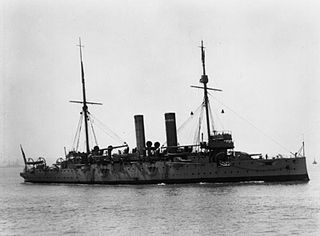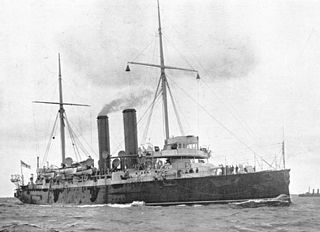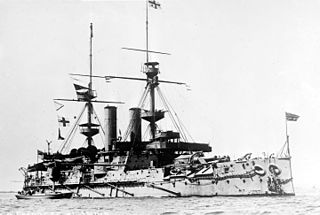
HMS Antelope was a Royal Navy Alarm-class torpedo gunboat. She was launched in 1893, reduced to harbour service from 1910 and was sold for scrapping in 1919.

HMS Camperdown was an Admiral-class battleship of the Royal Navy, named after Adam Duncan, 1st Viscount Duncan of Camperdown.

HMS Minerva was an Eclipse-class protected cruiser built for the Royal Navy in the mid-1890s.

HMS Resolution was a Royal Sovereign-class pre-dreadnought battleship of the Royal Navy. The ship was built by Palmers Shipbuilding and Iron Company, starting with her keel laying in June 1890. She was launched in May 1892 and, after completing trials, was commissioned into the Channel Squadron the following December. She was armed with a main battery of four 13.5-inch guns and a secondary battery of ten 6-inch guns. The ship had a top speed of 16.5 knots.

HMS Juno was an Eclipse-class protected cruiser built for the Royal Navy in the mid-1890s.

HMS Andromache was an Apollo-class protected cruiser of the Royal Navy. William Henry White designed her, and she was built at Chatham Dockyard and launched on 14 August 1890. The total cost of construction was £186,234.

A fleet review or naval review is an event where a gathering of ships from a particular navy is paraded and reviewed by an incumbent head of state and/or other official civilian and military dignitaries. A number of national navies continue to hold fleet reviews. Fleet reviews may also include participants and warships from multiple navies.

HMS Revenge was one of seven Royal Sovereign-class pre-dreadnought battleships built for the Royal Navy during the 1890s. She spent much of her early career as a flagship for the Flying Squadron and in the Mediterranean, Home and Channel Fleets. Revenge was assigned to the International Squadron blockading Crete during the 1897–1898 revolt there against the Ottoman Empire. She was placed in reserve upon her return home in 1900, and was then briefly assigned as a coast guard ship before she joined the Home Fleet in 1902. The ship became a gunnery training ship in 1906 until she was paid off in 1913.

HMS Crescent was a first class cruiser of the Edgar class in the British Royal Navy. Crescent, and her sister ship Royal Arthur, were built to a slightly modified design and are sometimes considered a separate class. She was launched in 1892, saw early service at the Australia Station and the North America and West Indies Station, served in the First World War, and was sold for breaking up in 1921.

HMS Endymion was a first-class protected cruiser of the Edgar class. She served in China during the Boxer Rebellion and later in the First World War, and was sold in 1920.

HMS St George was a first class cruiser of the Edgar class. She was launched on 23 June 1892.

HMS Brilliant was an Apollo-class cruiser of the British Royal Navy which served from 1893 to 1918 in various colonial posts and off the British Isles as a hastily converted minelayer during the First World War.

HMS Royal Sovereign was the lead ship of the seven ships in her class of pre-dreadnought battleships built for the Royal Navy in the 1890s. The ship was commissioned in 1892 and served as the flagship of the Channel Fleet for the next five years. She was transferred to the Mediterranean Fleet in 1897 and returned home in 1902, and was briefly assigned as a coast guard ship before she began a lengthy refit in 1903–1904. Royal Sovereign was reduced to reserve in 1905 and was taken out of service in 1909. The ship was sold for scrap four years later and subsequently broken up in Italy.

HMS Empress of India was one of seven Royal Sovereign-class pre-dreadnought battleships built for the Royal Navy during the 1890s. The ship was commissioned in 1893 and served as the flagship of the second-in-command of the Channel Fleet for two years. She was transferred to the Mediterranean Fleet in 1897, during which time Empress of India was assigned to the International Squadron blockading Crete during the uprising there. She returned home in 1901 and was briefly assigned as a coast guard ship in Ireland before she became the second flagship of the Home Fleet. The ship was reduced to reserve in 1905 and accidentally collided with the submarine HMS A10 the following year. Empress of India was taken out of service in early 1912 and accidentally struck a German sailing ship while under tow. She was sunk as a target ship in 1913.

HMS Prometheus was a Pelorus-class protected cruiser of the Royal Navy. Ten sister third class protected cruisers were built — designed by Sir William White. While well-armed for their size, they were primarily workhorses for the overseas fleet considered to be on police duties. She was sold for scrap in 1914.
Admiral Sir Alfred Leigh Winsloe, was a Royal Navy officer who went on to be Commander-in-Chief, China Station.
Admiral Hugh Pigot Williams was a British officer of the Royal Navy. In 1910–1912, while a Rear Admiral in the Royal Navy, he served as head of the British naval mission to the Ottoman Empire and Fleet Commander of the Ottoman Navy, at the rank of Liva Amiral.

Admiral John Luce, was a senior officer in the Royal Navy during and after the First World War. He played a significant role in the early development of British naval aviation and held command during the Battle of Coronel and the Battle of the Falkland Islands in the South Atlantic.

HMS Latona was an Apollo-class protected cruiser of the Royal Navy which served from 1890 to 1920.

HMS Naiad was an Apollo-class protected cruiser of the Royal Navy which served from 1892 to 1919.




















